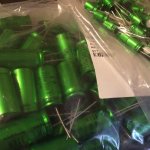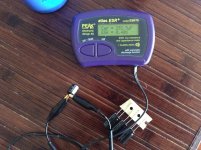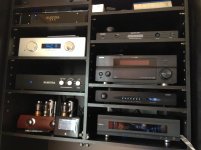Electrolytics - Polarized vs. Bipolar
Thank you all for the replies.
Just out of the curiosity (and learning by doing it), I just tried both types in a small Pioneer amp, and the Panasonic (bipolar) is MUCH MORE defined than the polarized Elna (which is "audio grade", mind you).
At least, that's my first impression. The Panasonic BP adds more soundstage, the Elna was just flat sound...
I'm going to leave the BP in the amp for a few days.
Thank you again.
An externally hosted image should be here but it was not working when we last tested it.
Thank you all for the replies.
Just out of the curiosity (and learning by doing it), I just tried both types in a small Pioneer amp, and the Panasonic (bipolar) is MUCH MORE defined than the polarized Elna (which is "audio grade", mind you).
At least, that's my first impression. The Panasonic BP adds more soundstage, the Elna was just flat sound...

I'm going to leave the BP in the amp for a few days.
Thank you again.
Bipolar really should only need ~2x the volume - so why the 2x dia And longer case?
must be some very different spec between them other than bipolar
Yes, that also caught my attention...

Normally the 2.2uF, the 3.3uF and even the 4.7uF are pretty small ones, in the 10 x 5 mm dimension.
These two 2.2uF bipolar I pulled them out from the PSU board of a TV (there were also 1 pair of complementary 2SA1535A / 2SC3944A, video transistors with fT of 200MHz).
Here the bipolar cap installed.  Note another 22uF bipolar cap at right, smaller...
Note another 22uF bipolar cap at right, smaller...
The TV model in which these BP caps were found, I believe it's the Panasonic TX-32PL1 and, according to its SM, there are 2 types of 2.2uF / 50V caps used in this model: ECEA1HN2R2 and ECA1HM2R2GB.
An externally hosted image should be here but it was not working when we last tested it.
The TV model in which these BP caps were found, I believe it's the Panasonic TX-32PL1 and, according to its SM, there are 2 types of 2.2uF / 50V caps used in this model: ECEA1HN2R2 and ECA1HM2R2GB.
Too bad there's not higher value one's available ....Read Bateman - adding bias isn't as good as a real bipolar cap for distortion
Section 5 shows with varying amounts of bias distortion does change on the polarized electrolytic, even back to back ones but it is still twice or more than the distortion of the bipolar electrolytic capacitor.
To qoute Batemen's summary:
" In every case the bipolar capacitor produced much lower levels of distortion than measured on similar value and voltage polar capacitors."
I thought they said that a back to back polar pair was just about the same as a bi-polar when used as a filter with a high AC voltage across the capacitors.Actually the bipolar caps are better than series connected polarized caps -
See Cryil Batemen cap articles
What was better for this filter duty was back to back bi-polar which turned out to be almost as good as MKT/MKS/Mylar film capacitors.
But the DC blocking capacitor at the input of an amplifier is not used to filter the audio signal. It has virtually no Audio Signal voltage across it/them. The results for filtering duty do not apply at this location.
Set the F-3dB of the DC blocking capacitor at least a decade below the required audio frequency passband and the capacitor can be just about any plastic film type. If you use electrolytic instead of film then lower the F-3db by another octave. This brings it to about the frequency where D.Self reports that distortion is inconsequential.
If you have an input impedance of 100k and 0.8uF (use 1uF), then you have that decade below 20Hz and for electrolytic use 2.2uF for <1/20th of 20Hz
What is the impedance it is feeding?An externally hosted image should be here but it was not working when we last tested it.
Thank you all for the replies.
Just out of the curiosity (and learning by doing it), I just tried both types in a small Pioneer amp, and the Panasonic (bipolar) is MUCH MORE defined than the polarized Elna (which is "audio grade", mind you).
At least, that's my first impression. The Panasonic BP adds more soundstage, the Elna was just flat sound...
I'm going to leave the BP in the amp for a few days.
Thank you again.
What is the filtering frequency?
Are you filtering off some of the audio band?
Electrolytics - Bipolar vs Polarized
Hi Andrew,
The 2.2uF bipolar is just replacing another polarized 2.2uF cap at the input of an amp. We know that a film cap in that position performs better than any electrolytic, but I am looking (and trying) if bipolar electrolytics perform any better than any "audio grade" polarized cap. And... so far, so good: the 2.2uF bipolar gives more dynamics, more details to the sound than its polarized audio grade counterpart, an "Elna For Audio" cap.
I'll leave the amp like this for a few days and later try a MKP cap of the same value to see how it performs. Thanks.

Hi Andrew,
The 2.2uF bipolar is just replacing another polarized 2.2uF cap at the input of an amp. We know that a film cap in that position performs better than any electrolytic, but I am looking (and trying) if bipolar electrolytics perform any better than any "audio grade" polarized cap. And... so far, so good: the 2.2uF bipolar gives more dynamics, more details to the sound than its polarized audio grade counterpart, an "Elna For Audio" cap.
I'll leave the amp like this for a few days and later try a MKP cap of the same value to see how it performs. Thanks.

My experience is that all film caps do not sound superior to all electrolytic caps. For example, I find that 4.7uF 50V 'N' type non-polar Black Gate electrolytic sounds far superior to an metalized polypropylene film ClarityCap when used for input signal coupling. Although Blacks Gates are out of production and becoming hard to find, a search of distributor stocks for a pair of non-polar BGs fitting your PCB would be well worth the effort, IMHO.
My experience is that all film caps do not sound superior to all electrolytic caps. For example, I find that 4.7uF 50V 'N' type non-polar Black Gate electrolytic sounds far superior to an metalized polypropylene film ClarityCap when used for input signal coupling. Although Blacks Gates are out of production and becoming hard to find, a search of distributor stocks for a pair of non-polar BGs fitting your PCB would be well worth the effort, IMHO.
This is true, I was shocked the MKP actually had slightly but measurable higher distortion vs Muse.
-
I have listened to a large number of caps like Vcap, Multicaps, teflons, Stealth caps, Dueland, etc. through totally direct coupled class A jfet/ fet audio system. Speakers are full range electrostatics with Raal ribbons and 2 JL Audio f212 subs. Over 100 Blackgate N caps for power supply decoupling, even the power amp has 700,000 uf CLC filtered with 100,000 uf of Blackgate as the final C.
The best electrolytics i have heard are the Blackgate N and NX , Muse bipolars, and Silmic/ Cerafines. But it depends on where in the circuit they are: for power supply decoupling it is different than dc blocking at device inputs to biased interstage coupling caps or used in singled end topologies. I like totally direct coupled best, but upgrade cap coupled projects like Sansui TU 9900 ( replace the output opamp with discrete jfet gain stage) and must use a coupling cap.
While like scotch we all have cap preferences Batemans articles provide evidence that bipolar electrolytics are worth auditioning and comparison to other choices. The higher voltage caps in any type of electrolytic are best as long as it fits.
The best electrolytics i have heard are the Blackgate N and NX , Muse bipolars, and Silmic/ Cerafines. But it depends on where in the circuit they are: for power supply decoupling it is different than dc blocking at device inputs to biased interstage coupling caps or used in singled end topologies. I like totally direct coupled best, but upgrade cap coupled projects like Sansui TU 9900 ( replace the output opamp with discrete jfet gain stage) and must use a coupling cap.
While like scotch we all have cap preferences Batemans articles provide evidence that bipolar electrolytics are worth auditioning and comparison to other choices. The higher voltage caps in any type of electrolytic are best as long as it fits.
Last edited:
I also tried some Silmic that were great at power decoupling, as signal coupling, they were less than stellar.
Those Muse BP were eye openers for sure, were used out of necessity, with their smaller size, yet were better than I would have hoped for with film capacitors.
I like the comparison to beverage preference, as varied as can be.
Those Muse BP were eye openers for sure, were used out of necessity, with their smaller size, yet were better than I would have hoped for with film capacitors.
I like the comparison to beverage preference, as varied as can be.
Hi Peter,
I will often use capacitors higher in voltage ratings so that the leads fit exactly in the holes in the PCB. The flatter top supply AC voltage shows that the conduction angle for the diodes has increased - which is good. Use the regular (and highly engineered) rectifier diodes.
Hi Jean-Paul,
Newer Tantalum capacitors are under-rated by voltage, which was the common way to avoid burning blobs. The electronics you are talking about have space as a critical parameter, so there is pressure to go to the smallest package for capacitance.
Tantalum capacitors still sound awful, and can often be replaced with Poly-Aluminum types. I use these instead, and they perform very well. Don't forget that Tantalum capacitors are still intolerant of even brief reverse polarity and heat. Of course, heat attacks every type of capacitor. Some more than others. The only Tantalum capacitors I like are the wet slug variety, but they are very expensive.
-Chris
Hi Chris,
A lot has happen since my last post.
I have to report back that after replacing unknowns to 5100uf/25v X 8 in a psu of a commercial preamp that I had, I'd had the opportunity to compared it with the AVM ovation PA8 preamp that was optioned with XLR in/outputs. The AVM Ovation PA8 has both valve and SS output with a RRP $20kAUD.
Ok, the AVM Ovation PA8, was the leader in SQ, especially the valve stage, however I'm blown away at how close this pre came. It's about 85% of the AVM Ovation PA8. Well you would expect AVM to win! Considering the $$$ and the reputation. Overall I'm very happy with the 5100uf/25V x8 implementation.
I also purchased a Peak Atlas ESR70 that gives me the capability to measure the capacitance and ESR at an instant.. Excellent little device...
Attachments
Hi Chris,
A lot has happen since my last post.
I have to report back that after replacing unknowns to 5100uf/25v X 8 in a psu of a commercial preamp that I had, I'd had the opportunity to compared it with the AVM ovation PA8 preamp that was optioned with XLR in/outputs. The AVM Ovation PA8 has both valve and SS output with a RRP $20kAUD.
Ok, the AVM Ovation PA8, was the leader in SQ, especially the valve stage, however I'm blown away at how close this pre came. It's about 85% of the AVM Ovation PA8. Well you would expect AVM to win! Considering the $$$ and the reputation. Overall I'm very happy with the 5100uf/25V x8 implementation.
I also purchased a Peak Atlas ESR70 that gives me the capability to measure the capacitance and ESR at an instant.. Excellent little device...
What commercial preamp is that? What does it use inside, parts type and all that?
Just upgrading the ps capacitors shouldn't make too much in difference, except on the audio quality. That is, it may sound different, not necessarily better or worst.
What commercial preamp is that? What does it use inside, parts type and all that?
Just upgrading the ps capacitors shouldn't make too much in difference, except on the audio quality. That is, it may sound different, not necessarily better or worst.
I've been to a couple of Get-to-getter and this pre blew the 2 other preamp that was there including a valve that was hand built in Poland or Germany that wasn't cheap. When I finally got my unit and put it on there was something I didn't like. It sounded broken! That was confirmed when someone brought over his entire rig to my place with. Manley preamp that was full valve base.
Putting in the Panasonic FC to replace unknowns in the amplifier VAS for psu decoupling made the SQ holographic, placing the the The Panasonic TP5100uf/25v brought the SQ presentation Smoother more realistic. Crank the volume up and it gives the AVM PA8 a run for the money.. It's now a keeper! At this GTG, the AVM was the star of the show, it made the SQ of instruments clearer more defined and easier to accept, the Sanders pre was just behind compared to the rest. The Valve pre there you see on the left I won't mentioned the brand was a total disappointment and a disaster, I'm very sure it's due to the built quality! The newly built Electra is inbetween and also good value.
Most who were there would agree with these comments.
Attachments
Last edited:
Hi Chris,
A lot has happen since my last post.
I have to report back that after replacing unknowns to 5100uf/25v X 8 in a psu of a commercial preamp that I had, I'd had the opportunity to compared it with the AVM ovation PA8 preamp that was optioned with XLR in/outputs. The AVM Ovation PA8 has both valve and SS output with a RRP $20kAUD.
Ok, the AVM Ovation PA8, was the leader in SQ, especially the valve stage, however I'm blown away at how close this pre came. It's about 85% of the AVM Ovation PA8. Well you would expect AVM to win! Considering the $$$ and the reputation. Overall I'm very happy with the 5100uf/25V x8 implementation.
I also purchased a Peak Atlas ESR70 that gives me the capability to measure the capacitance and ESR at an instant.. Excellent little device...
So yours is a Manley preamp? Which model?
No, mine is a Sanders pre, I A/B that to the Manley Neo 300b Classic
- Home
- Design & Build
- Parts
- Best electrolytic capacitors


